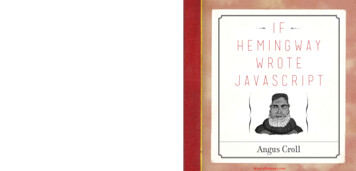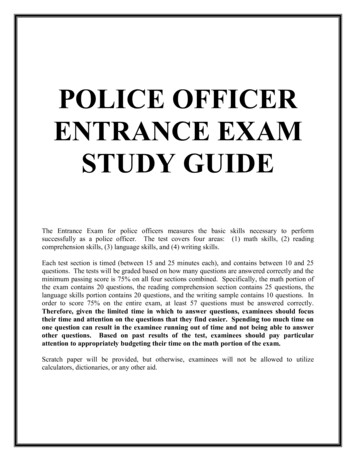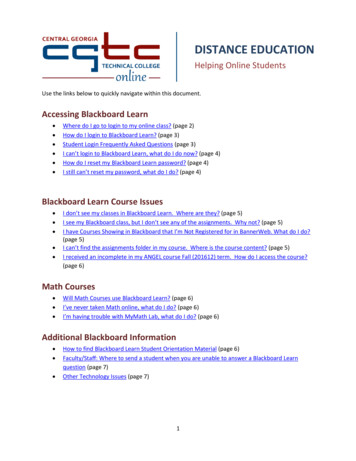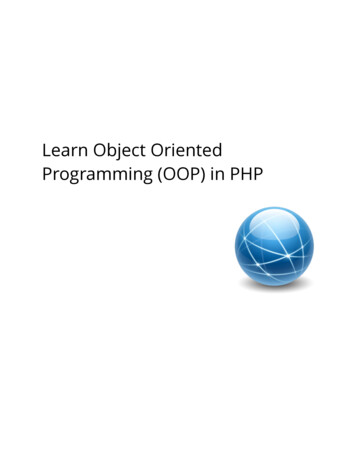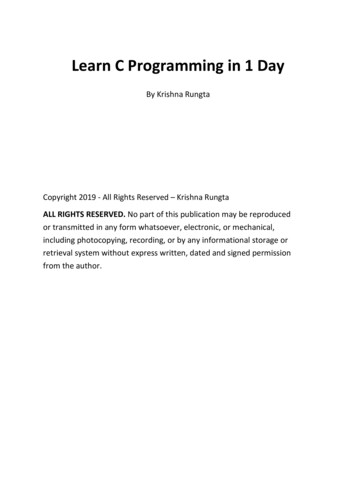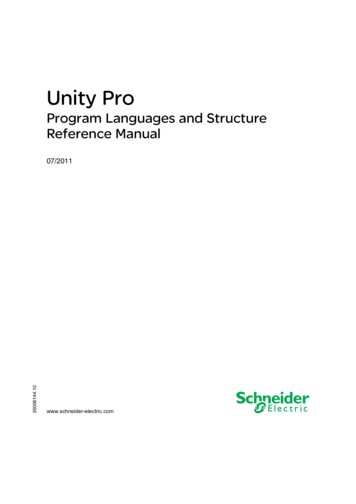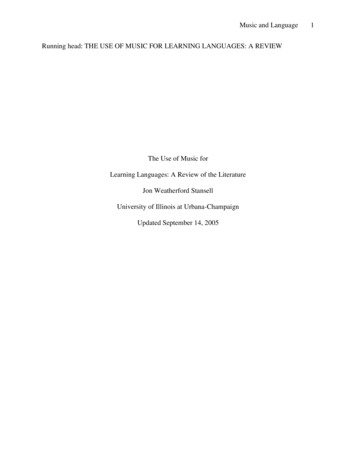
Transcription
dart#dart
Table of ContentsAbout1Chapter 1: Getting started with ples5Installation or Setup5Automated installation and updates5Manual install5Hello, World!5Http Request6Html6Dart6Example6Getters and SettersChapter 2: Asynchronous ProgrammingExamples688Returning a Future using a Completer8Async and Await8Converting callbacks to Futures9Chapter 3: ClassesExamples1010Creating a class10Members10Constructors11Chapter 4: CollectionsExamplesCreating a new List131313
Creating a new Set13Creating a new Map13Map each element in the collection.14Filter a list14Chapter 5: Comments16Syntax16Remarks16Examples16End of Line Comment16Multi-Line Comment16Documentation using Dartdoc16Chapter 6: Control Flow18Examples18If Else18While Loop18For Loop19Switch Case19Chapter 7: Converting Data21Examples21JSON21Chapter 8: Dart-JavaScript interoperability22Introduction22Examples22Calling a global function22Wrapping JavaScript classes/namespaces22Passing object literals23Chapter 9: Date and time24ExamplesBasic usage of DateTimeChapter 10: EnumsExamplesBasic usage2424252525
Chapter 11: Exceptions26Remarks26Examples26Custom exception26Chapter 12: Functions27Remarks27Examples27Functions with named parameters27Function scoping27Chapter 13: Libraries29Remarks29Examples29Using libraries29Libraries and visibility29Specifying a library prefix30Importing only part of a library30Lazily loading a library30Chapter 14: List Filters32Introduction32Examples32Filtering a list of integersChapter 15: Pub3233Remarks33Examples33pub build33pub serve33Chapter 16: Regular 34
Create and use a Regular ExpressionChapter 17: StringsExamples343535Concatenation and interpolation35Valid strings35Building from parts35Credits37
AboutYou can share this PDF with anyone you feel could benefit from it, downloaded the latest versionfrom: dartIt is an unofficial and free dart ebook created for educational purposes. All the content is extractedfrom Stack Overflow Documentation, which is written by many hardworking individuals at StackOverflow. It is neither affiliated with Stack Overflow nor official dart.The content is released under Creative Commons BY-SA, and the list of contributors to eachchapter are provided in the credits section at the end of this book. Images may be copyright oftheir respective owners unless otherwise specified. All trademarks and registered trademarks arethe property of their respective company owners.Use the content presented in this book at your own risk; it is not guaranteed to be correct noraccurate, please send your feedback and corrections to info@zzzprojects.comhttps://riptutorial.com/1
Chapter 1: Getting started with dartRemarksDart is an open-source, class-based, optionally-typed programming language for building webapplications--on both the client and server--created by Google. Dart’s design goals are: Create a structured yet flexible language for web programming. Make Dart feel familiar and natural to programmers and thus easy to learn. Ensure that Dart delivers high performance on all modern web browsers and environmentsranging from small handheld devices to server-side execution.Dart targets a wide range of development scenarios, from a one-person project without muchstructure to a large-scale project needing formal types in the code to state programmer intent.To support this wide range of projects, Dart provides the following features and tools: Optional types: this means you can start coding without types and add them later asneeded. Isolates: concurrent programming on server and client Easy DOM access: using CSS selectors (the same way that jQuery does it) Dart IDE Tools: Dart plugins exist for many commonly used IDEs, Ex: WebStorm. Dartium: a build of the Chromium Web Browser with a built-in Dart Virtual MachineLinks The Dart HomepageOfficial Dart News & UpdatesThe Dartosphere - A collection of recent Dart blog postsDartisans Dartisans community on Google Dart Web Development - Google Groups PageDart Language Misc - Google Groups PageDartLang sub-RedditDocumentation Tour of the Dart LanguageTour of the Dart LibrariesDart Code samplesDart API Referencehttps://riptutorial.com/2
FAQ Frequently Asked QuestionsVersionsVersionRelease ptutorial.com/3
VersionRelease torial.com/4
VersionRelease .0.0.10 r307982013-12-021.0.0.3 r301882013-11-120.8.10.10 r301072013-11-080.8.10.6 r300362013-11-070.8.10.3 r298032013-11-04ExamplesInstallation or SetupThe Dart SDK includes everything you need to write and run Dart code: VM, libraries, analyzer,package manager, doc generator, formatter, debugger, and more. If you are doing webdevelopment, you will also need Dartium.Automated installation and updates Installing Dart on Windows Installing Dart on Mac Installing Dart on LinuxManual installYou can also manually install any version of the SDK.Hello, World!Create a new file named hello world.dart with the following content:void main() {print('Hello, World!');}In the terminal, navigate to the directory containing the file hello world.dart and type the following:dart hello world.darthttps://riptutorial.com/5
Hit enter to display Hello,World!in the terminal window.Http RequestHtml img id "cats" /img Dartimport 'dart:html';/// Stores the image in [blob] in the [ImageElement] of the given [selector].void setImage(selector, blob) {FileReader reader new FileReader();reader.onLoad.listen((fe) {ImageElement image document.querySelector(selector);image.src ) async {var url 28/Tortoiseshell she-cat.JPG";// Initiates a request and asynchronously waits for the result.var request await HttpRequest.request(url, responseType: 'blob');var blob request.response;setImage("#cats", blob);}Examplesee Example on 989cac6969aGetters and Settersvoid main() {var cat new Cat();print("Is cat hungry?print("Is cat cuddly?print("Feed cat.");cat.isHungry false;print("Is cat hungry?print("Is cat cuddly? {cat.isHungry}"); {cat.isCuddly}");// Is cat hungry? true// Is cat cuddly? false {cat.isHungry}"); {cat.isCuddly}");// Is cat hungry? false// Is cat cuddly? true}class Cat {bool isHungry true;bool get isCuddly ! isHungry;https://riptutorial.com/6
bool get isHungry isHungry;bool set isHungry(bool hungry) this. isHungry hungry;}Dart class getters and setters allow APIs to encapsulate object state changes.See dartpad example here: 990f3313233Read Getting started with dart online: rted-with-darthttps://riptutorial.com/7
Chapter 2: Asynchronous ProgrammingExamplesReturning a Future using a CompleterFuture Results costlyQuery() {var completer new Completer();database.query("SELECT * FROM giant table", (results) {// when completecompleter.complete(results);}, (error) {completer.completeException(error);});// this returns essentially immediately,// before query is finishedreturn completer.future;}Async and Awaitimport 'dart:async';Future main() async {var value await waitForValue();print("Here is the value: value");//since waitForValue() returns immediately if you un it without await you won't get theresultvar errorValue "not finished yet";waitForValue();print("Here is the error value: value");// not finished yet}Future int waitForValue() new Future((){var n 100000000;// Do some long processfor (var i 1; i n; i ) {// Print out progress:if ([n / 2, n / 4, n / 10, n / 20].contains(i)) {print("Not done yet.");}// Return value when done.if (i n) {print("Done.");return i;}}});https://riptutorial.com/8
See example on Dartpad: 3e16e53613cConverting callbacks to FuturesDart has a robust async library, with Future, Stream, and more. However, sometimes you mightrun into an asynchronous API that uses callbacks instead of Futures. To bridge the gap betweencallbacks and Futures, Dart offers the Completer class. You can use a Completer to convert acallback into a Future.Completers are great for bridging a callback-based API with a Future-based API. For example,suppose your database driver doesn't use Futures, but you need to return a Future. Try this code:// A good use of a Completer.Future doStuff() {Completer completer new Completer();runDatabaseQuery(sql, (results) {completer.complete(results);});return completer.future;}If you are using an API that already returns a Future, you do not need to use a Completer.Read Asynchronous Programming online: usprogramminghttps://riptutorial.com/9
Chapter 3: ClassesExamplesCreating a classClasses can be created as follow:class InputField {int maxLength;String name;}The class can be instantiated using the new keyword after which the field values will be null bydefault.var field new InputField();Field values can then be accessed:// this will trigger the setterfield.name "fieldname";// this will trigger the getterprint(field.name);MembersA class can have members.Instance variables can be declared with/without type annotations, and optionally initialized.Uninitialised members have the value of null, unless set to another value by the constructor.class Foo {var member1;int member2;String member3 "Hello world!";}Class variables are declared using the static keyword.class Bar {static var member4;static String member5;static int member6 42;}If a method takes no arguments, is fast, returns a value, and doesn't have visible side-effects, thenhttps://riptutorial.com/10
a getter method can be used:class Foo {String get bar {var result;// .return result;}}Getters never take arguments, so the parentheses for the (empty) parameter list are omitted bothfor declaring getters, as above, and for calling them, like so:main() {var foo new Foo();print(foo.bar); // prints "bar"}There are also setter methods, which must take exactly one argument:class Foo {String bar;String get bar bar;void set bar(String value) {bar value;}}The syntax for calling a setter is the same as variable assignment:main() {var foo new Foo();foo.bar "this is calling a setter method";}ConstructorsA class constructor must have the same name as its class.Let's create a constructor for a class Person:class Person {String name;String gender;int age;Person(this.name, this.gender, this.age);}The example above is a simpler, better way of defining the constructor than the following way,which is also possible:https://riptutorial.com/11
class Person {String name;String gender;int age;Person(String name, String gender, int age) {this.name name;this.gender gender;this.age age;}}Now you can create an instance of Person like this:var alice new Person('Alice', 'female', 21);Read Classes online: ps://riptutorial.com/12
Chapter 4: CollectionsExamplesCreating a new ListLists can be created in multiple ways.The recommended way is to use a List literal:var vegetables ['broccoli', 'cabbage'];The List constructor can be used as well:var fruits new List();If you prefer stronger typing, you can also supply a type parameter in one of the following ways:var fruits String ['apples', 'oranges'];var fruits new List String ();For creating a small growable list, either empty or containing some known initial values, the literalform is preferred. There are specialized constructors for other kinds of lists:varvarvarvarfixedLengthList1 new List(8);fixedLengthList2 new List.filled(8, "initial text");computedValues new List.generate(8, (n) "x" * n);fromIterable new List String .from(computedValues.getRange(2, 5));See also the Effective Dart style guide about collections.Creating a new SetSets can be created via the constructor:var ingredients new Set();ingredients.addAll(['gold', 'titanium', 'xenon']);Creating a new MapMaps can be created in multiple ways.Using the constructor, you can create a new map as follow:var searchTerms new Map();https://riptutorial.com/13
Types for the key and value can also be defined using generics:var nobleGases new Map int, String ();var nobleGases int, String {};Maps can otherwise be created using the map literal:var map {"key1": "value1","key2": "value2"};Map each element in the collection.All collection objects contain a map method that takes a Function as an argument, which must takea single argument. This returns an Iterable backed by the collection. When the Iterable isiterated, each step calls the function with a new element of the collection, and the result of the callbecomes the next element of the iteration.You can turn an Iterable into a collection again by using the Iterable.toSet() or Iterable.toList()methods, or by using a collection constructor which takes an iterable like Queue.from or List.from.Example:main() {var cats ['Abyssinian','Scottish Fold','Domestic Shorthair'];print(cats); // [Abyssinian, Scottish Fold, Domestic Shorthair]var catsInReverse cats.map((String cat) {return new List(); // [nainissybA, dloF hsittocS, riahtrohS citsemoD]print(catsInReverse);}See dartpad example here: 3c7008a6fa1Filter a listDart allows to easily filter a list using where.var fruits ['apples', 'oranges', 'bananas'];fruits.where((f) f.startsWith('a')).toList(); //applesOf course you can use some AND or OR operators in your where clause.https://riptutorial.com/14
Read Collections online: https://riptutorial.com/15
Chapter 5: CommentsSyntax // Single-line comment /* Multi-line/In-line comment */ /// Dartdoc commentRemarksIt is good practice to add comments to your code to explain why something is done or to explainwhat something does. This helps any future readers of your code to more easily understand yourcode.Related topic(s) not on StackOverflow: Effective Dart: DocumentationExamplesEnd of Line CommentEverything to the right of // in the same line is commented.int i 0; // Commented out textMulti-Line CommentEverything between /* and */ is commented.void main() {for (int i 0; i 5; i ) {/* This is commented, andwill not affect code */print('hello {i 1}');}}Documentation using DartdocUsing a doc comment instead of a regular comment enables dartdoc to find it and generatedocumentation for it./// The number of characters in this chunk when unsplit.int get length .https://riptutorial.com/16
You are allowed to use most markdown formatting in your doc comments and dartdoc will processit accordingly using the markdown ///////////////////////////This is a paragraph of regular text.This sentence has *two* emphasized words (i.e. italics) and **two**strong ones (bold).A blank line creates another separate paragraph. It has some inline code delimited using backticks.* Unordered lists.* Look like ASCII bullet lists.* You can also use - or .Links can be:* http://www.just-a-bare-url.com* [with the URL inline](http://google.com)* [or separated out][ref link][ref link]: http://google.com# A Header## A subheaderRead Comments online: tps://riptutorial.com/17
Chapter 6: Control FlowExamplesIf ElseDart has If Else:if (year 2001) {print('21st century');} else if (year 1901) {print('20th century');} else {print('We Must Go Back!');}Dart also has a ternary if operator:var foo true;print(foo ? 'Foo' : 'Bar'); // Displays "Foo".While LoopWhile loops and do while loops are allowed in Dart:while(peopleAreClapping()) {playSongs();}and:do {processRequest();} while(stillRunning());Loops can be terminated using a break:while (true) {if (shutDownRequested()) break;processIncomingRequests();}You can skip iterations in a loop using continue:for (var i 0; i bigNumber; i ) {if rial.com/18
}For LoopTwo types of for loops are allowed:for (int month 1; month 12; month ) {print(month);}and:for (var object in flybyObjects) {print(object);}The for-in loop is convenient when simply iterating over an Iterable collection. There is also aforEach method that you can call on Iterable objects that behaves like for-in:flybyObjects.forEach((object) print(object));or, more concisely:flybyObjects.forEach(print);Switch CaseDart has a switch case which can be used instead of long if-else statements:var command 'OPEN';switch (command) {case 'CLOSED':executeClosed();break;case 'OPEN':executeOpen();break;case 'APPROVED':executeApproved();break;case 'UNSURE':// missing break statement means this case will fall through// to the next statement, in this case the default casedefault:executeUnknown();}You can only compare integer, string, or compile-time constants. The compared objects must beinstances of the same class (and not of any of its subtypes), and the class must not override .https://riptutorial.com/19
One surprising aspect of switch in Dart is that non-empty case clauses must end with break, orless commonly, continue, throw, or return. That is, non-empty case clauses cannot fall through.You must explicitly end a non-empty case clause, usually with a break. You will get a staticwarning if you omit break, continue, throw, or return, and the code will error at that location atruntime.var command 'OPEN';switch (command) {case 'OPEN':executeOpen();// ERROR: Missing break causes an exception to be thrown!!case 'CLOSED': // Empty case falls throughcase 'LOCKED':executeClosed();break;}If you want fall-through in a non-empty case, you can use continue and a label:var command 'OPEN';switch (command) {case 'OPEN':executeOpen();continue locked;locked: case 'LOCKED':executeClosed();break;}Read Control Flow online: whttps://riptutorial.com/20
Chapter 7: Converting DataExamplesJSONimport 'dart:convert';void main() {var jsonString """{"cats": {"abysinnian": {"origin": "Burma","behavior": "playful"}}}""";var obj ian']['behavior']); // playful}See example on dartpad: 27b062108feRead Converting Data online: -datahttps://riptutorial.com/21
Chapter 8: Dart-JavaScript interoperabilityIntroductionDart-JavaScript interoperability lets us run JavaScript code from our Dart programs.The interoperability is achieved by using the js library to create Dart stubs. These stubs describethe interface we'd like to have with the underlying JavaScript code. At runtime calling the Dart stubwill invoke the JavaScript code.ExamplesCalling a global functionSuppose we'd like to invoke the JavaScript function JSON.stringify which receives an object,encodes it into a JSON string and returns it.All we'd have to do is write the function signature, mark it as external and annotate it with the @JSannotation:@JS("JSON.stringify")external String stringify(obj);The @JS annotation will be used from here on out to mark Dart classes that we'd like to use inJavaScript as well.Wrapping JavaScript classes/namespacesSuppose we'd like to wrap the Google Maps JavaScript API google.maps:@JS('google.maps')library maps;import "package:js/js.dart";@JS()class Map {external Map(Location location);external Location getLocation();}We now have the Map Dart class which corresponds to the JavaScript google.maps.Map class.Running newMap(someLocation)in Dart will invoke newgoogle.maps.Map(location)in JavaScript.Note that you don't have to name your Dart class the same as the JavaScript class:@JS("LatLng")https://riptutorial.com/22
class Location {external Location(num lat, num lng);}The Location Dart class corresponds to the google.maps.LatLng class.Using inconsistent names is discouraged as they can create confusion.Passing object literalsIt's common practice in JavaScript to pass object literals to functions:// JavaScriptprintOptions({responsive: true});Unfortunately we cannot pass Dart Map objects to JavaScript in these cases.What we have to do is create a Dart object that represents the object literal and contains all of itsfields:// Dart@JS()@anonymousclass Options {external bool get responsive;external factory Options({bool responsive});}Note that the Options Dart class doesn't correspond to any JavaScript class. As such we mustmark it with the @anonymous annotation.Now we can create a stub for the original printOptions function and call it with a new Optionsobject:// Dart@JS()external printOptions(Options options);printOptions(new Options(responsive: true));Read Dart-JavaScript interoperability online: criptinteroperabilityhttps://riptutorial.com/23
Chapter 9: Date and timeExamplesBasic usage of DateTimeDateTime now new DateTime.now();DateTime berlinWallFell new DateTime(1989, 11, 9);DateTime moonLanding DateTime.parse("1969-07-20 20:18:00");// 8:18pmYou can find more in depth information here.Read Date and time online: imehttps://riptutorial.com/24
Chapter 10: EnumsExamplesBasic usageenum Fruit {apple, banana}main() {var a Fruit.apple;switch (a) {case Fruit.apple:print('it is an apple');break;}// get all the values of the enumsfor (List Fruit value in Fruit.values) {print(value);}// get the second valueprint(Fruit.values[1]);}Read Enums online: ://riptutorial.com/25
Chapter 11: ExceptionsRemarksDart code can throw and catch exceptions. Exceptions are errors indicating that somethingunexpected happened. If the exception isn’t caught, the isolate that raised the exception issuspended, and typically the isolate and its program are terminated.In contrast to Java, all of Dart’s exceptions are unchecked exceptions. Methods do not declarewhich exceptions they might throw, and you are not required to catch any exceptions.Dart provides Exception and Error types, as well as numerous predefined subtypes. You can, ofcourse, define your own exceptions. However, Dart programs can throw any non-null object—notjust Exception and Error objects—as an exception.ExamplesCustom exceptionclass CustomException implements Exception {String cause;CustomException(this.cause);}void main() {try {throwException();} on CustomException {print("custom exception is been obtained");}}throwException() {throw new CustomException('This is my first custom exception');}Read Exceptions online: https://riptutorial.com/26
Chapter 12: FunctionsRemarksDart is a true object-oriented language, so even functions are objects and have a type, Function.This means that functions can be assigned to variables or passed as arguments to other functions.You can also call an instance of a Dart class as if it were a function.ExamplesFunctions with named parametersWhen defining a function, use {param1, param2, } to specify named parameters:void enableFlags({bool bold, bool hidden}) {// .}When calling a function, you can specify named parameters using paramName: valueenableFlags(bold: true, hidden: false);Function scopingDart functions may also be declared anonymously or nested. For example, to create a nestedfunction, just open a new function block within an existing function blockvoid outerFunction() {bool innerFunction() {/// Does stuff}}The function innerFunction may now be used inside, and only inside, outerFunction. No other otherfunctions has access to it.Functions in Dart may also be declared anonymously, which is commonly used as functionarguments. A common example is the sort method of List object. This method takes an optionalargument with the following signature:int compare(E a, E b)The documentation states that the function must return 0 if the a and b are equal. It returns -1 if ab and 1 if a b.https://riptutorial.com/ 27
Knowing this, we can sort a list of integers using an anonymous function.List int numbers [4,1,3,5,7];numbers.sort((int a, int b) {if(a b) {return 0;} else if (a b) {return -1;} else {return 1;}});Anonymous function may also be bound to identifiers like so:Function intSorter (int a, int b) {if(a b) {return 0;} else if (a b) {return -1;} else {return 1;}}and used as an ordinary variable.numbers.sort(intSorter);Read Functions online: ttps://riptutorial.com/28
Chapter 13: LibrariesRemarksThe import and library directives can help you create a modular and shareable code base. EveryDart app is a library, even if it doesn’t use a library directive. Libraries can be distributed usingpackages. See Pub Package and Asset Manager for information about pub, a package managerincluded in the SDK.ExamplesUsing librariesUse import to specify how a namespace from one library is used in the scope of another library.import 'dart:html';The only required argument to import is a URI specifying the library. For built-in libraries, the URIhas the special dart: scheme. For other libraries, you can use a file system path or the package:scheme. The package: scheme specifies libraries provided by a package manager such as the pubtool. For example:import 'dart:io';import 'package:mylib/mylib.dart';import 'package:utils/utils.dart';Libraries and visibilityUnlike Java, Dart doesn’t have the keywords public, protected, and private. If an identifier startswith an underscore , it’s private to its library.If you for example have class A in a separate library file (eg, other.dart), such as:library other;class A {int private 0;testA() {print('int value: private'); // 0private 5;print('int value: private'); // 5}}and then import it into your main app, such as:https://riptutorial.com/29
import 'other.dart';void main() {var b new B();b.testB();}class B extends A {String private;testB() {private 'Hello';print('String value: private'); // HellotestA();print('String value: private'); // Hello}}You get the expected output:String value: Helloint value: 0int value: 5String value: HelloSpecifying a library prefixIf you import two libraries that have conflicting identifiers, then you can specify a prefix for one orboth libraries. For example, if library1 and library2 both have an Element class, then you mighthave code like this:import 'package:lib1/lib1.dart';import 'package:lib2/lib2.dart' as lib2;// .var element1 new Element(); // Uses Element from lib1.var element2 new lib2.Element();// Uses Element from lib2.Importing only part of a libraryIf you want to use only part of a library, you can selectively import the library. For example:// Import only foo and bar.import 'package:lib1/lib1.dart' show foo, bar;// Import all names EXCEPT foo.import 'package:lib2/lib2.dart' hide foo;Lazily loading a libraryDeferred loading (also called lazy loading) allows an application to load a library on demand, if andwhen it’s needed. To lazily load a library, you must first import it using deferred as.https://riptutorial.com/30
import 'package:deferred/hello.dart' deferred as hello;When you need the library, invoke loadLibrary() using the library’s identifier.greet() async {await hello.loadLibrary();hello.printGreeting();}In the preceding code, the await keyword pauses execution until the library is loaded. For moreinformation about async and await, see more examples here asynchrony support or visit theasynchrony support part of the language tour.Read Libraries online: ttps://riptutorial.com/31
Chapter 14: List FiltersIntroductionDart filters lists through the List.where and List.retainWhere methods. The where function takes oneargument: a boolean function that is applied to each element of the list. If the function evaluates totrue then the list element is retained; if the function evaluates to false, the element is removed.Calling theList.retainWhere(foo) is practically equivalent to setting theList theList.where(foo).ExamplesFiltering a list of integers[-1, 0, 2, 4, 7, 9].where((x) x 2) -- [4, 7, 9]Read List Filters online: ershttps://riptutorial.com/32
Chapter 15: PubRemarksWhen you install the Dart SDK, one of the tools that you get is pub. The pub tool providescommands for a variety of purposes. One command installs packages, another starts up an HTTPserver for testing, another prepares your app for deployment, and another publishes your packageto pub.dartlang.org. You can access the pub commands either through an IDE, such asWebStorm, or at the command line.For an overview of these commands, see Pub Commands.Examplespub buildUse pub build when you’re ready to deploy your web app. When you run pub build, it generatesthe assets for the current package and all of its dependen
It is an unofficial and free dart ebook created for educational purposes. All the content is extracted from Stack Overflow Documentation,


